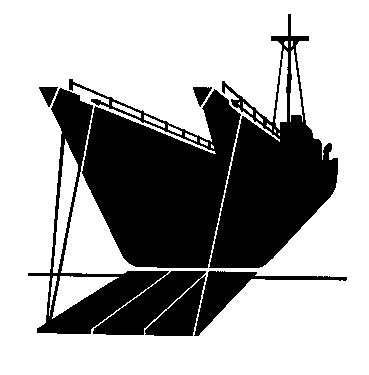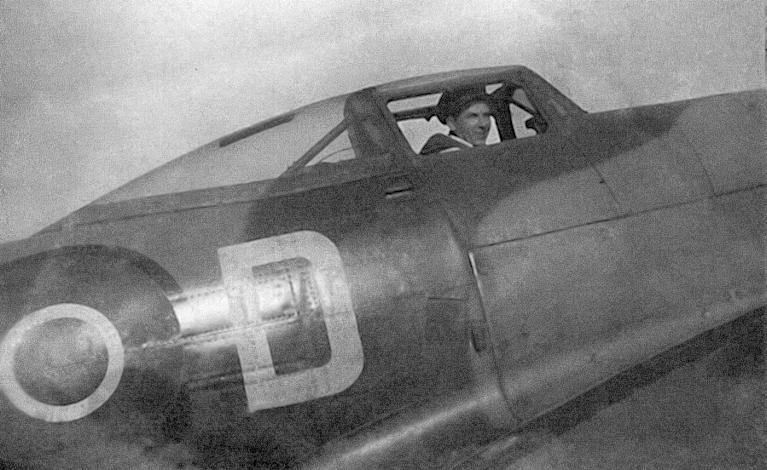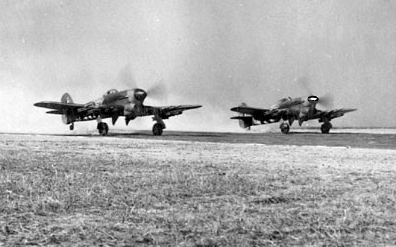

Vol 9. Issue No 2.
The 60th D-Day Anniversary edition
© Wartime News
Typhoons Over Normandy
by Ken Trott

This remarkable account of a Typhoon Pilot appears as the lead story in the 60th Anniversary D-Day edition of Wartime News. This personal episode in the life of a fighter pilot demonstrates just how committed these men were and the risks they had to take to defeat the enemy.
I volunteered for the RAF in April 1941 at the age of
18 and joined the RAF Volunteer Reserve in September of that year
as a Trainee Cadet Pilot.
My initial training was done on ground subjects at Torquay, before
being posted overseas to Canada for flying training. In September
1942, I received my ‘Wings’ and
was commissioned as a Pilot Officer.
On my return to England in October 1942, I was posted firstly to Peterborough
and in early 1943 to Millfield, near Berwick-on-Tweed, to fly Hawker Hurricanes.
A posting to 195 Squadron in April took me to Woodvale Airfield near Southport,
Lancashire, which was equipped with Typhoon single seat fighters. Soon after,
the squadron was moved to Norfolk where I spent several months doing operation
patrols over the North Sea and Holland.
In September, my squadron was again moved, this time to Fairlop Airfield in Essex.
From there, we carried out operations over France, often flying down to Manston
Airfield in Kent for briefings. In early 1944, 195 Sqn was disbanded and I moved
to 197 Squadron stationed at Tangmere Airfield, West Sussex. The Typhoons were
then equipped with bomb racks under each wing to take 500 or 1000 pound bombs.
Our main operational work was attacking radar and V1 sites, as well as being
on escort and standby duties.
In April, we moved to Needs Oar Point near the Beaulieu River, overlooking the
Solent and the Isle of Wight, and became part of the 2nd Tactical Air Force.
197 Squadron, along with numbers 257, 266 and 193, then became known as 146 Wing,
all operating from the same airfield in preparation for D-Day.
Throughout May 1944, we were constantly called upon to make attacks against radar
targets along the coast of France, as well as the V1 sites.
I have no entry in my flying log book for 2 or 4 June. This may have been due
to the bad weather which we had about that time. On 3 June, we made a high level
dive bombing attack on the radar site at Cap d’Antifer, not far from Le
Havre. This involved our crossing over the French coast, high enough to avoid
the light flak, and then turning 180° in a dive bombing attack on the German
radar sites with a final burst of our cannon fire before levelling out over the
sea at about 500 knots. Then, forming up in sections of four in battle formation
for our return home with a total flying time of 1 hour 15 minutes.
Later in the day, orders were received to paint the broad black and white invasion
stripes on the wings and fuselage of our Typhoons, hopefully to identify ‘friend
from foe’, both in the air and on the ground. Needless to say, a lot of
paint was splashed around by both pilots and ground crew, and a great sense of
anticipation was felt by everyone.
On 5 June, I started off by air testing one of our new Typhoons, which had just
been delivered. This was one of the first four bladed types which had begun to
arrive on the squadron. In the evening of D-Day-1, we carried out another operation
over the French coast. I noted in my log book “large convoys of LCTs seen
heading towards Cherbourg”. In fact, the Channel was covered with boats
of various kinds - a fantastic sight and it seemed impossible that the Germans
did not know what we were up to.

On
our return to Needs Oar Point, all squadron pilots were told
to attend a large mess tent where a covered blackboard was set
up. We were then informed by the
senior officer present that the next day, 6 June, would be D-Day. The blackboard
was then unveiled to reveal the proposed landings, etc.
We were told to turn in early as we should be on call from approximately 0400
hrs the next morning. Needless to say, the roar of aircraft going overhead towards
France made sleep almost impossible in our tents. We all took an early breakfast
and reported to our various dispersals, where the ground crew were already running
up the Sabre engines of our Typhoons. Then they were refuelled while we awaited
the first calls to briefing and also listened to the BBC radio broadcasts.
My squadron was first involved at 0710 hrs, eight aircraft being led by Wing
Commander Baker, who later lost his life over Normandy on 16 June. They attacked
targets in a low level assault south of Bayeux and all returned safely at 0820.
As soon as the aircraft from the first operation of the day had landed and taxied
in, they were surrounded by both ground crew and the other pilots on standby,
who were checking firstly to see if the muzzle (the mouth of the cannon) covers
had been blown off, which would indicate that each of the four 20 mm cannons
had been fired, and then if there was any flak damage to the aircraft.
As soon as the pilots had climbed down, we all wanted to know what it was like
over the beachhead. “Any enemy aircraft seen? How much flak? The weather
conditions? What targets had been attacked?”
Meanwhile, the Squadron Intelligence Officer was hovering around, wanting to
speak to each pilot who had taken part in this our first operation of D-Day.
Having slung their parachutes over their shoulders, many walked away to light
a cigarette before giving way to the countless questions still coming from all
sides. The aircraft were now surrounded by the ground crews, busy refuelling
and re-arming to get them ready as soon as possible for the next operation.
I was not involved in the first operation of the day, but was requested later
in the morning to fly the Wing Intelligence Officer to a meeting at Thorney Island,
using the Auster aircraft. This was a pre-war airfield, not far from Portsmouth
and, while waiting, I observed a great deal of aerial activity - Typhoons on
standby, and light bombers overhead from airfields further away.
On my return to Needs Oar Point, I remained on call until 1750 hrs when eight
of us were briefed to carry out a reconnaissance south of Caen. My log book indicates
that this involved low level bombing on an emergency supply dump, which was left
with black smoke and flames coming from the target area. We all returned at 1920.
The third operation by my squadron took off at 2105, this time led by our Commanding
Officer, S/Ldr Taylor. Again, eight aircraft were involved, the operation being
an armed reconnaissance in the Caen/Bayeux area. They landed back at 2215, and
so ended D-Day.
From D-Day+1, we continued at standby until called upon to provide close support
to the Canadian Army, as well as specialist operations on selected targets. 146
Wing only lost one pilot that day, although my best friend failed to return from
an operation in the area of St Lo the following day and was later reported killed
in action.
In early July, we moved from Needs Oar Point to Hurn in preparation for the move
to our new airfield in Normandy.
On 8 July, we landed at B3 St Croix on the beachhead and were due to stay
a few days. We were about to return to Hurn on the evening of the 13th when
we were briefed to conduct an armed recce over the Caen area. Four of us took
off, led by Wing Commander Baldwin. I spotted an armoured carrier and requested
permission to attack with my No 2. We strafed and immobilised the vehicle and
were about to return to it when we received orders to get back up quickly as
the others were being attacked by about thirty Me109s. We immediately took
them on and I made a head-on attack which resulted in a collision. I was thrown
from my aircraft, managed to pull my rip cord but then became unconscious.
When I came to, I was hanging by my parachute from a tree surrounded by Germans,
taken prisoner and subsequently spent the next ten months as a PoW, most of
the time at Stalag Luft III.
In all, during the ten weeks of the Battle of Normandy, 150 Typhoon pilots
lost their lives, while many others were taken prisoners of war. To commemorate
this battle, and in particular the part played by the Typhoon, a memorial has
been erected near the village of Noyers-Bocage, about ten miles south west
of Caen.
My initial training was done on ground subjects at Torquay, before being posted overseas to Canada for flying training. In September 1942, I received my ‘Wings’ and was commissioned as a Pilot Officer.
On my return to England in October 1942, I was posted firstly to Peterborough and in early 1943 to Millfield, near Berwick-on-Tweed, to fly Hawker Hurricanes. A posting to 195 Squadron in April took me to Woodvale Airfield near Southport, Lancashire, which was equipped with Typhoon single seat fighters. Soon after, the squadron was moved to Norfolk where I spent several months doing operation patrols over the North Sea and Holland.
In September, my squadron was again moved, this time to Fairlop Airfield in Essex. From there, we carried out operations over France, often flying down to Manston Airfield in Kent for briefings. In early 1944, 195 Sqn was disbanded and I moved to 197 Squadron stationed at Tangmere Airfield, West Sussex. The Typhoons were then equipped with bomb racks under each wing to take 500 or 1000 pound bombs. Our main operational work was attacking radar and V1 sites, as well as being on escort and standby duties.
In April, we moved to Needs Oar Point near the Beaulieu River, overlooking the Solent and the Isle of Wight, and became part of the 2nd Tactical Air Force. 197 Squadron, along with numbers 257, 266 and 193, then became known as 146 Wing, all operating from the same airfield in preparation for D-Day.
Throughout May 1944, we were constantly called upon to make attacks against radar targets along the coast of France, as well as the V1 sites.
I have no entry in my flying log book for 2 or 4 June. This may have been due to the bad weather which we had about that time. On 3 June, we made a high level dive bombing attack on the radar site at Cap d’Antifer, not far from Le Havre. This involved our crossing over the French coast, high enough to avoid the light flak, and then turning 180° in a dive bombing attack on the German radar sites with a final burst of our cannon fire before levelling out over the sea at about 500 knots. Then, forming up in sections of four in battle formation for our return home with a total flying time of 1 hour 15 minutes.
Later in the day, orders were received to paint the broad black and white invasion stripes on the wings and fuselage of our Typhoons, hopefully to identify ‘friend from foe’, both in the air and on the ground. Needless to say, a lot of paint was splashed around by both pilots and ground crew, and a great sense of anticipation was felt by everyone.
On 5 June, I started off by air testing one of our new Typhoons, which had just been delivered. This was one of the first four bladed types which had begun to arrive on the squadron. In the evening of D-Day-1, we carried out another operation over the French coast. I noted in my log book “large convoys of LCTs seen heading towards Cherbourg”. In fact, the Channel was covered with boats of various kinds - a fantastic sight and it seemed impossible that the Germans did not know what we were up to.
On our return to Needs Oar Point, all squadron pilots were told to attend a large mess tent where a covered blackboard was set up. We were then informed by the senior officer present that the next day, 6 June, would be D-Day. The blackboard was then unveiled to reveal the proposed landings, etc.
We were told to turn in early as we should be on call from approximately 0400 hrs the next morning. Needless to say, the roar of aircraft going overhead towards France made sleep almost impossible in our tents. We all took an early breakfast and reported to our various dispersals, where the ground crew were already running up the Sabre engines of our Typhoons. Then they were refuelled while we awaited the first calls to briefing and also listened to the BBC radio broadcasts.
My squadron was first involved at 0710 hrs, eight aircraft being led by Wing Commander Baker, who later lost his life over Normandy on 16 June. They attacked targets in a low level assault south of Bayeux and all returned safely at 0820. As soon as the aircraft from the first operation of the day had landed and taxied in, they were surrounded by both ground crew and the other pilots on standby, who were checking firstly to see if the muzzle (the mouth of the cannon) covers had been blown off, which would indicate that each of the four 20 mm cannons had been fired, and then if there was any flak damage to the aircraft.
As soon as the pilots had climbed down, we all wanted to know what it was like over the beachhead. “Any enemy aircraft seen? How much flak? The weather conditions? What targets had been attacked?”
Meanwhile, the Squadron Intelligence Officer was hovering around, wanting to speak to each pilot who had taken part in this our first operation of D-Day. Having slung their parachutes over their shoulders, many walked away to light a cigarette before giving way to the countless questions still coming from all sides. The aircraft were now surrounded by the ground crews, busy refuelling and re-arming to get them ready as soon as possible for the next operation.
I was not involved in the first operation of the day, but was requested later in the morning to fly the Wing Intelligence Officer to a meeting at Thorney Island, using the Auster aircraft. This was a pre-war airfield, not far from Portsmouth and, while waiting, I observed a great deal of aerial activity - Typhoons on standby, and light bombers overhead from airfields further away.
On my return to Needs Oar Point, I remained on call until 1750 hrs when eight of us were briefed to carry out a reconnaissance south of Caen. My log book indicates that this involved low level bombing on an emergency supply dump, which was left with black smoke and flames coming from the target area. We all returned at 1920.
The third operation by my squadron took off at 2105, this time led by our Commanding Officer, S/Ldr Taylor. Again, eight aircraft were involved, the operation being an armed reconnaissance in the Caen/Bayeux area. They landed back at 2215, and so ended D-Day.
From D-Day+1, we continued at standby until called upon to provide close support to the Canadian Army, as well as specialist operations on selected targets. 146 Wing only lost one pilot that day, although my best friend failed to return from an operation in the area of St Lo the following day and was later reported killed in action.
In early July, we moved from Needs Oar Point to Hurn in preparation for the move to our new airfield in Normandy.
On 8 July, we landed at B3 St Croix on the beachhead and were due to stay
a few days. We were about to return to Hurn on the evening of the 13th when
we were briefed to conduct an armed recce over the Caen area. Four of us took
off, led by Wing Commander Baldwin. I spotted an armoured carrier and requested
permission to attack with my No 2. We strafed and immobilised the vehicle and
were about to return to it when we received orders to get back up quickly as
the others were being attacked by about thirty Me109s. We immediately took
them on and I made a head-on attack which resulted in a collision. I was thrown
from my aircraft, managed to pull my rip cord but then became unconscious.
When I came to, I was hanging by my parachute from a tree surrounded by Germans,
taken prisoner and subsequently spent the next ten months as a PoW, most of
the time at Stalag Luft III.
In all, during the ten weeks of the Battle of Normandy, 150 Typhoon pilots
lost their lives, while many others were taken prisoners of war. To commemorate
this battle, and in particular the part played by the Typhoon, a memorial has
been erected near the village of Noyers-Bocage, about ten miles south west
of Caen.
Click here for a WAAF's story or Click here to return to home page
This document maintained by
www.barringtonward.com}.
Material
Copyright ©The Wartime Company.